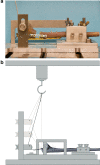"Mother and baby plate": a strategy to improve stability in proximal fractures of the ulna
- PMID: 37460845
- PMCID: PMC10491518
- DOI: 10.1007/s00402-023-04979-8
"Mother and baby plate": a strategy to improve stability in proximal fractures of the ulna
Abstract
Introduction: Proximal ulna fractures with a large zone of comminution, such as in the context of Monteggia injuries, require mechanically strong osteosyntheses as they occur in regions with high physiological joint load. Consequently, implant failure and pseudarthrosis are critical and devastating complications, especially with the background of mainly young patients being affected. An effective solution could be provided by adding a small second plate 90° angulated to the standard dorsal plate in the area of non-union. Thus, this study investigates whether, from a biomechanical point of view, the use of such a mini or baby plate is worthwhile.
Materials and methods: Comminuted fractures distal to the coronoid process, equivalent to Jupiter type IIb fractures, are generated on artificial Sawbones® of the ulna and stabilized using two different plate osteosyntheses: in the first group, a dorsal locking compression olecranon plate is used (LCP group). In the second group, a small, ulnar 5-hole olecranon plate is added as a baby plate in addition to the mother plate at the level of the fracture zone (MBP group). Dynamic biomechanical loading in degrees of flexion from 0° to 90° is carried out to determine yield load, stiffness, displacement, and changes in fracture gap width as well as bending of the dorsal plate.
Results: The "mother-baby-plate" osteosynthesis had a significantly higher yield load (p < 0.01) and stiffness (p = 0.01) than the LCP group. This correlates with the increased movement of the proximal fracture element during cyclic testing for the LCP group compared to the MBP group as measured by an optical metrology system.
Conclusions: Here, we show evidence that the addition of a small plate to the standard plate is highly effective in increasing the biomechanical stability in severe fractures equivalent to Jupiter type IIb. As it hopefully minimizes complications like pseudarthrosis and implant failure and as the additional preparatory effort leading to compromised blood supply is regarded to be negligible, this justifies and highly advises the use of a mother-baby-plate system.
Keywords: Biomechanical; Double-plate; Fracture; Monteggia; Mother–baby; Plate; Ulna.
© 2023. The Author(s).
Conflict of interest statement
The authors have no competing interests to declare that are relevant to the content of this article.
Figures





Similar articles
-
Low-profile double plating versus dorsal LCP in stabilization of the olecranon fractures.Arch Orthop Trauma Surg. 2021 Feb;141(2):245-251. doi: 10.1007/s00402-020-03473-9. Epub 2020 May 16. Arch Orthop Trauma Surg. 2021. PMID: 32417960 Free PMC article.
-
Biomechanical evaluation of two innovative locking implants for comminuted olecranon fractures under high-cycle loading conditions.Injury. 2015;46(6):985-9. doi: 10.1016/j.injury.2015.02.010. Epub 2015 Feb 18. Injury. 2015. PMID: 25771445
-
Reconstruction of Monteggia-like proximal ulna fractures using different fixation devices: A biomechanical study.Injury. 2016 Aug;47(8):1636-41. doi: 10.1016/j.injury.2016.05.010. Epub 2016 May 10. Injury. 2016. PMID: 27242331
-
[Proximal ulna fractures].Z Orthop Unfall. 2011 Jun;149(3):e1-e19. doi: 10.1055/s-0030-1271144. Epub 2011 Jun 28. Z Orthop Unfall. 2011. PMID: 21713726 Review. German.
-
Biomechanical and biological aspects of defect treatment in fractures using helical plates.Acta Chir Orthop Traumatol Cech. 2014;81(4):267-71. Acta Chir Orthop Traumatol Cech. 2014. PMID: 25137496 Review.
Cited by
-
Orthogonal plating for complex olecranon fractures: retrospective case series with patient-reported outcomes.Arch Orthop Trauma Surg. 2024 Aug;144(8):3237-3245. doi: 10.1007/s00402-024-05444-w. Epub 2024 Jul 5. Arch Orthop Trauma Surg. 2024. PMID: 38967783 Free PMC article.
-
Suture lasso combined with lateral plate in comminuted transolecranon fracture-dislocations of the elbow.BMC Surg. 2025 May 28;25(1):234. doi: 10.1186/s12893-025-02972-z. BMC Surg. 2025. PMID: 40437464 Free PMC article.
-
[Implant anchorage: In vivo and in vitro analyses : Clusters for implant anchorage and safety].Orthopadie (Heidelb). 2024 Jul;53(7):519-526. doi: 10.1007/s00132-024-04519-1. Epub 2024 Jun 3. Orthopadie (Heidelb). 2024. PMID: 38829401 Review. German.
References
-
- Theopold J, Schleifenbaum S, Muller M, Werner M, Hammer N, Josten C, Hepp P. Biomechanical evaluation of hybrid double plate osteosynthesis using a locking plate and an inverted third tubular plate for the treatment of proximal humeral fractures. PLoS ONE. 2018;13(10):e0206349. doi: 10.1371/journal.pone.0206349. - DOI - PMC - PubMed
MeSH terms
Grants and funding
LinkOut - more resources
Full Text Sources
Medical
Research Materials
Miscellaneous

